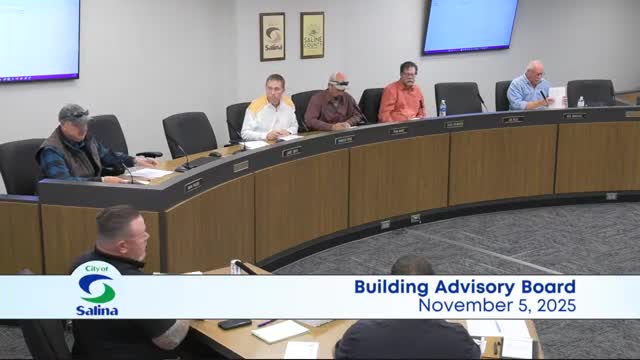Board debates retroactive sprinklers and access rules in proposed International Fire Code changes
November 05, 2025 | Salina, Saline County, Kansas
This article was created by AI summarizing key points discussed. AI makes mistakes, so for full details and context, please refer to the video of the full meeting. Please report any errors so we can fix them. Report an error »

The Salina Building Advisory Board on Nov. 5, 2025, opened an extended discussion of proposed International Fire Code (IFC) changes that would affect life-safety requirements for existing assembly occupancies and subdivision access.
Fire Marshal Joe Kvasick described the IFC provision commonly called "retroactive sprinkling": after years of NIST research and national discussion following the Station nightclub fire, the model code narrows the requirement to certain A-2 occupancies (bars, nightclubs, banquet halls, similar assembly uses). Kvasick said NIST preferred a broader retroactive requirement but the International Code Council (ICC) and IFC limited the model-code retrofit trigger in practice. The draft language under review would apply in some circumstances where occupant loads exceed thresholds and where fire-area or story conditions apply; staff noted other code triggers (for example, fire area over 5,000 square feet or occupant load thresholds used in the model code).
Commissioners raised concerns about community institutions such as the VFW and Moose Lodge, which hold community breakfasts and events and which some speakers said could not afford full retrofits. Board members suggested staff perform a facility inventory and discuss realistic occupant loads, possible separations (rated walls) or alternative means of compliance, and phased compliance windows so small nonprofit operators would have time to budget and plan. Lauren Driscoll, director of community and development services, and staff said they would identify affected facilities and arrange site visits; the board agreed staff should return with a draft ordinance and the results of those visits before making a formal recommendation.
Separately, staff presented proposed changes to Appendix D (remoteness) that affect when a single entrance for a residential subdivision is acceptable. The proposed local approach would keep the underlying model code's intent but offer a practical alternative: for developments where the half-diagonal remoteness calculation is infeasible because of irregular lot shapes, the staff recommended setting a minimum separation threshold of 300 feet as an objective criterion for exemptions, with additional criteria (future access, existing infrastructure, topography) to guide decisions. Staff and the board discussed that the remoteness rule is not only a fire issue but can affect emergency medical services and police access; the board emphasized life-safety and asked staff to coordinate with fire, EMS and planning.
No formal ordinance vote was taken on the IFC at the Nov. 5 meeting. Staff proposed to return within about two weeks with a draft IFC ordinance, a list of affected A-2 facilities, and recommended compliance windows and alternatives for smaller operators.
Fire Marshal Joe Kvasick described the IFC provision commonly called "retroactive sprinkling": after years of NIST research and national discussion following the Station nightclub fire, the model code narrows the requirement to certain A-2 occupancies (bars, nightclubs, banquet halls, similar assembly uses). Kvasick said NIST preferred a broader retroactive requirement but the International Code Council (ICC) and IFC limited the model-code retrofit trigger in practice. The draft language under review would apply in some circumstances where occupant loads exceed thresholds and where fire-area or story conditions apply; staff noted other code triggers (for example, fire area over 5,000 square feet or occupant load thresholds used in the model code).
Commissioners raised concerns about community institutions such as the VFW and Moose Lodge, which hold community breakfasts and events and which some speakers said could not afford full retrofits. Board members suggested staff perform a facility inventory and discuss realistic occupant loads, possible separations (rated walls) or alternative means of compliance, and phased compliance windows so small nonprofit operators would have time to budget and plan. Lauren Driscoll, director of community and development services, and staff said they would identify affected facilities and arrange site visits; the board agreed staff should return with a draft ordinance and the results of those visits before making a formal recommendation.
Separately, staff presented proposed changes to Appendix D (remoteness) that affect when a single entrance for a residential subdivision is acceptable. The proposed local approach would keep the underlying model code's intent but offer a practical alternative: for developments where the half-diagonal remoteness calculation is infeasible because of irregular lot shapes, the staff recommended setting a minimum separation threshold of 300 feet as an objective criterion for exemptions, with additional criteria (future access, existing infrastructure, topography) to guide decisions. Staff and the board discussed that the remoteness rule is not only a fire issue but can affect emergency medical services and police access; the board emphasized life-safety and asked staff to coordinate with fire, EMS and planning.
No formal ordinance vote was taken on the IFC at the Nov. 5 meeting. Staff proposed to return within about two weeks with a draft IFC ordinance, a list of affected A-2 facilities, and recommended compliance windows and alternatives for smaller operators.
View full meeting
This article is based on a recent meeting—watch the full video and explore the complete transcript for deeper insights into the discussion.
View full meeting
